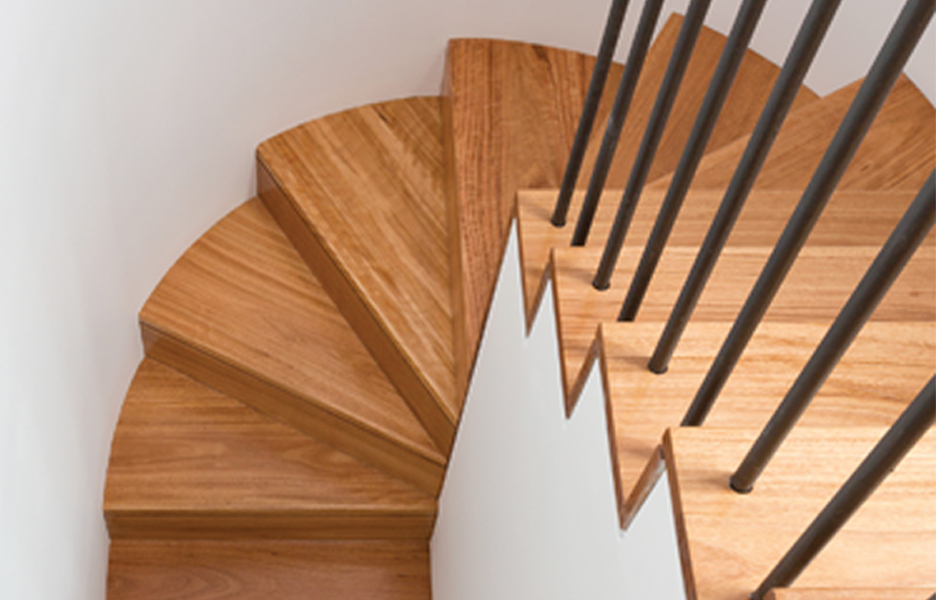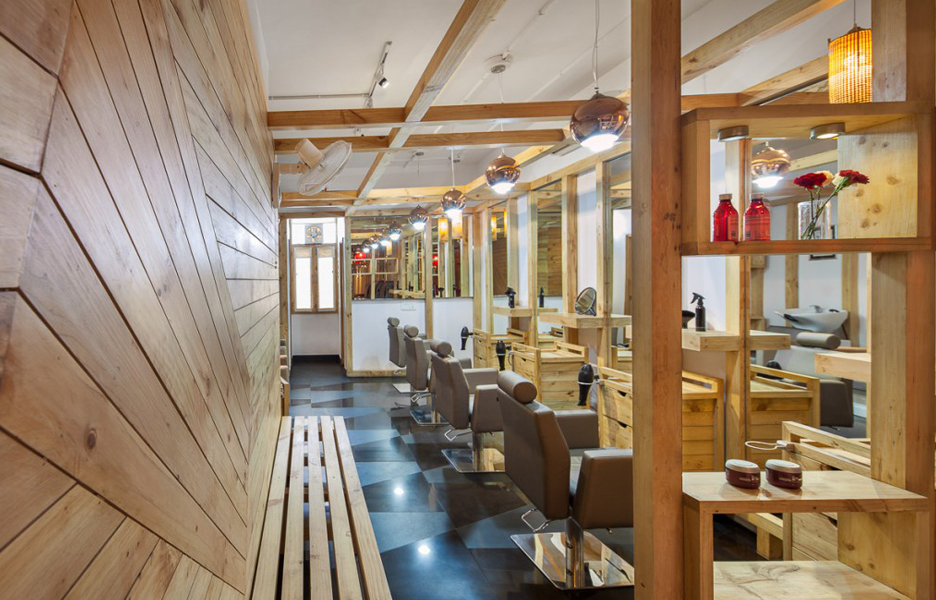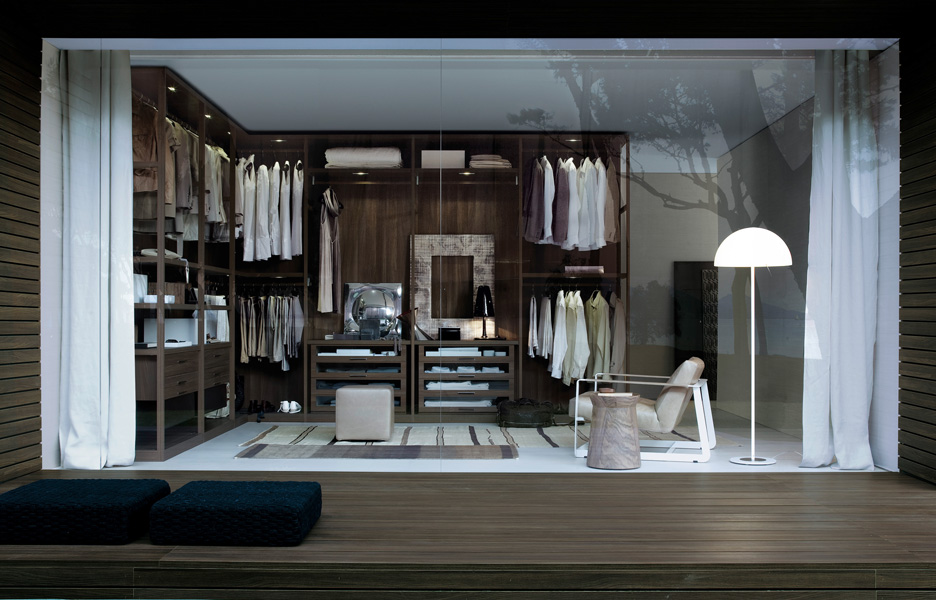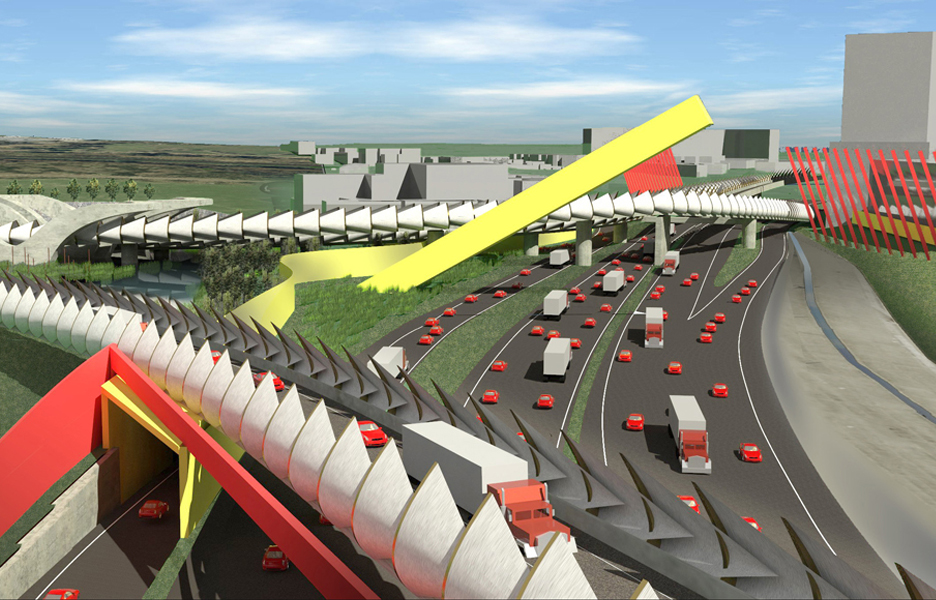
Space language – Sneakerboy by March Studio
Space language – Sneakerboy by March Studio
Share
Location: Melbourne, Australia
Design: March Studio
Text: Gillian Serisier
Photography: Peter Bennetts
Within the high-tech, high-speed rubric of William Gibson, Stanley Kubrick’s 2001: A Space Odyssey and the perennial signifier of scientific intervention, high-speed travel, Sneakerboy by March Studio is a sleek pan Asian vision of the future.
Developing an identity from conception has allowed a brand vision to emerge through the visual language of computer graphics writ large as recurring motifs on chairs, shelves, website and logo. It has also allowed March Studio to explore visual keys to the conceptual premise of online shopping in developing the stores as a physical portal.
The studio was approached mid-year to conceptualise, identify and deliver a unique online retail experience. The brief also required two stores by the end of the year. Effectively, the client required a physical store where shoes could be tried on, but not sold. Rather, shoes are ordered online and shipped from Hong Kong. “We hadn’t had a brief this intriguing for a long time… a fantastic opportunity as we didn’t have to have storage,” says March Studio architect Rodney Eggleston, adding, “not having all that stock means you can fit an enormous store into a really small space.” It’s an outcome that has been fully exploited with some 500 shoes simultaneously displayed in around 76 square metres of space.
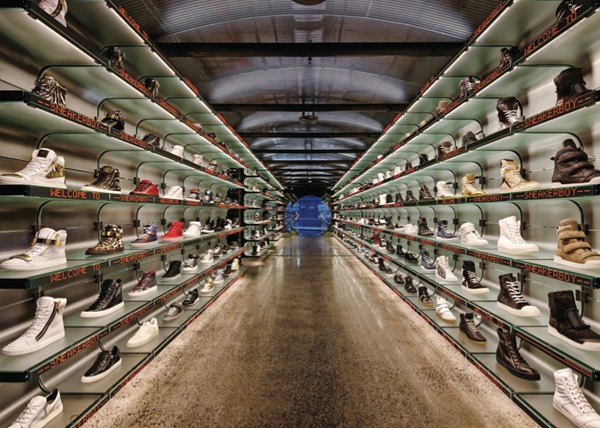
Curved glass shelves allow the imbedded technology, including interactive RFID chips and connective cabling to be seen.
Kubrick is arguably the most obvious of the store design influences. Underlying this is a shared sense of spatial void coupled with the repetition inherent to 2001 (1968) and revisited in the bathroom scene of The Shining (1980). The round store entrance and infinity-like staging of translucent glass shelves drive this home. “We worked a lot in terms of developing brand identity, logos and web design, as we tried to capture what Sneakerboy was as a brand. Part of that strategy was to have a façade they can really own, so when they expand into other cities you can see the glass box façade and immediately identify with it as a Sneakerboy store,” says Eggleston.
Rather than present a series of boxes, the shoe display comprises a bespoke solution of curved glass shelving that extends the entire length of the store. Visually reinforcing this, the whole, while backlit, is also lit evenly on all sides. Suspended just above the floor and slightly below the ceiling, the sense of being both of and within the space is further exaggerated by a continuous LED display running along the shelf edge. In unison these repeated lines act as perspective lines shooting off to the unknowable infinity in space afforded by an end wall of mirror reflecting the round entrance door. It is a neat trick, but also, in looking like a tunnel, a reference to subways – in particular, the New York subway strike of 1966, which ostensibly shifted sneakers from the realm of utility to that of fashion item. This allusion is delivered through a perforated steel ceiling: “We thought about when sneakers became fashionable during the New York subway strike, where people had to wear their Reebok trainers to work. Because of that subway and transportation culture we started looking at train stations and Parliament Station [Melbourne] is certainly being referenced. The perforated ceiling and the tunnel, also the spun chairs you find in the Metro in Paris. Definitely looking at that utilitarian infrastructure is inspirational to some of the finishes in the space,” says Eggleston.
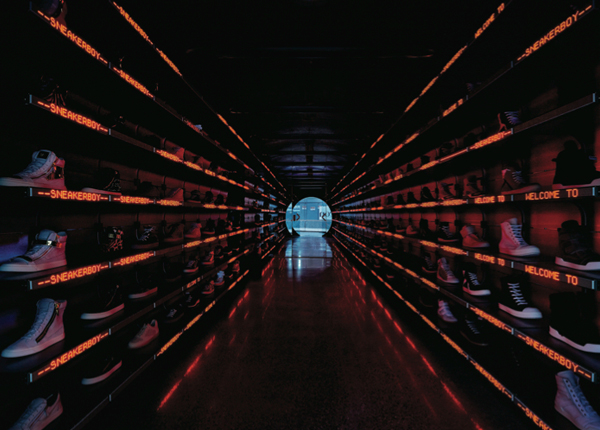
Red LED lights running the length of the store exaggerate the tunnel effect of the round portal-like entry.
As a nod to the departure from traditional retail, where street display is essential to marketing, March Studio has chosen to obfuscate the internal view of a portion of the store. “We were exploring ideas of privacy, we wanted the light to come in, but not a full vision of the store. We like the idea of obscuring vision into that space and creating an air of exclusivity,” says Eggleston. Within this area, the chairs are similarly of a retro futuristic ilk denoted by the whole. Comprising a back-to-back arrangement of six spun steel seats (powder coated white in Melbourne, polished and swivelling in Sydney), each is anchored by a conjoined steel support. The whole is presented on a concrete plinth above a highly polished concrete floor – as a robust sculptural form for trying on shoes with a degree of privacy not possible in the main viewing room.
For this area, the glass shelves have been replaced with three-millimetre laser cut steel. Flowing from wall to ceiling, the individual shoe zone of each shelf is demarked by the slightly curved tab of computer icons. Weighing close to a tonne, the walls are an amazing piece of engineering that splits down the middle to slide forward and reveal changing rooms. On the ceiling, the steel is used to continue the visual of the walls while hiding and exposing services such as speakers, lighting and sprinklers.
For each chair, and in another nod to speculative fiction, touchscreen technology (predicted by scientist Vannevar Bush in 1945 and fictionalised by Stanislaw Lem in Return from the Stars, 1961) allows extended cyber browsing while in-store. Indeed, the internet as an experiential portal presents as a parallel to Gibson’s speculative fiction. This is particularly true of the interactive technology that recognises shoppers and posts a cheery and personalised greeting along the LED-lit shelf edge as you browse the shoes. Behind the curtain, RFID chips in the shelves provide the technology to support the personalised interaction, including information about whether the shoe is available in your size.
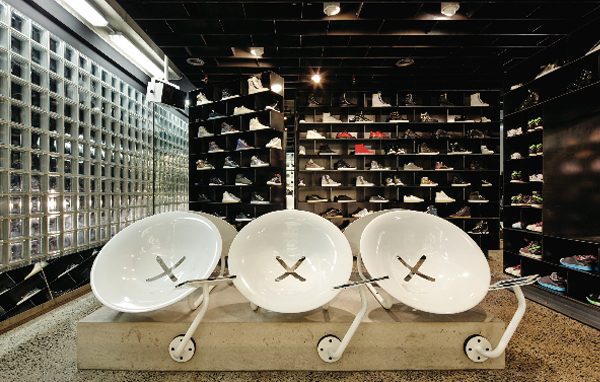
Spun steel chairs, similar to those found in Metro stations, lend a science fiction ambience to the online experience.
Chips in the shoes are geared for more generic responses such as sizes available, colour and cost. The technology in the store is both extremely responsive and extremely visible. As Eggleston explains, while the glass shelving started as a means to evenly light the shoes, a further application soon presented itself, whereby 50 kilometres of cables could be visible.
“We wanted to expose the inner workings: all the technology; the bunches of cables all strapped together with cable ties. We’re not trying to hide that, we’re trying to show the connection to the online world.” Further influencing this decision was the conceptual conundrum of the internet, which allows us to push a button or swipe a screen with no comprehension of the massive servers sustaining the online world.
Bringing the physical and virtual worlds together is the simple graphic language of the first computers (OCR-A). The iconic slightly rounded square cross, for example, is a feature of the chairs and door. Where the chairs boast a cut iteration, the door graphic denotes a solid floating on glass that splits when the doors are opened, whereupon it is reinvented as a pair of forward and back icons. On the website, the font is subtly inserted as the brand title, while the body text remains a contemporary font. The combination works well to differentiate brand from information and is fresh and unlaboured for doing so.
Conceptually robust, there is a depth and nuance evident in March Studio’s Sneakerboy stores that speak volumes. Rather than caricature the referential elements of a project with touchstone clichés, the design ideas are allowed to play out their tangents. The subway strike leading to a Parliament Station reference, for example, is in no way obvious. Instead, it is the subtle insertion of a known aesthetic within a broader dialogue and it is this intelligent and experience driven response to designing that makes March Studio one of the finest.
You Might also Like
